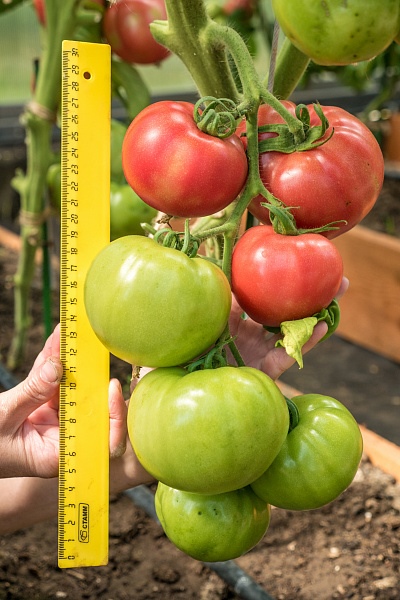
- Authors: Kiramov O.D.
- Year of approval: 2018
- Category: hybrid
- Growth type: indeterminate
- Appointment: fresh consumption
- Ripening period: mid-early
- Ripening time, days: 95-105
- Growing conditions: for open ground, for film greenhouses
- Leaves: medium length, green in color
- Unripe fruit color: light green
Tomato Raspberry Idea, indeed, can be a good idea for refreshing a collection of familiar varieties. But only a gardener who has carefully studied all the relevant information can count on success. You need to know everything about planting and about the biological properties of the culture.
Breeding history
It has been officially allowed to use the Raspberry Idea in personal gardens since 2018. The originator of this variety is such a well-known specialist as OD Kiramov. The plant was obtained by hybridization. It must be emphasized that it has absorbed all the achievements of modern breeding.
Description of the variety
The Raspberry Idea is an excellent indeterminate hybrid. It can be planted both in ordinary vegetable gardens and under polyethylene. Moderately long foliage develops on the bushes. It is characterized by a simple green color.
The main qualities of the fruit
In the first days after folding the berries from the ovaries, they are characterized by a light green color. As it develops, it is replaced by a beautiful pink color. The stalks are fully articulated. Tomatoes are large, and some of them can weigh 300 g. In shape, they resemble a stylized heart, and also have slightly pronounced ribs. 5-7 tomatoes can appear on 1 brush; the first of them will appear above 6, 7 or 8 sheets, and the next ones go through 1-2 sheets.
Taste characteristics
The pulp of the Raspberry Idea reaches a medium density. The smooth skin does not have any significant effect on the taste of these fruits. The meatiness and sugar content of the berries are important attractive properties. Unsurprisingly, overall they get an excellent tasting rating.
Ripening and fruiting
Raspberry Idea is a typical mid-early tomato. If the weather corresponds to the usual climatic norm, the collection of fruits begins 95-105 days after the spring seedlings hatch. But, of course, sometimes the whims of nature force us to significantly adjust this familiar schedule.
Yield
The minimum collection of fruits is declared at the level of 16.5 kg per 1 sq. m. In favorable conditions, it can reach 18.5 kg. Therefore, we can confidently say that this plant has a high yield. But at the same time, success in growing the Raspberry Idea largely depends on the diligence of farmers and the correct choice of agricultural technology.
The timing of planting seedlings and planting in the ground
It is necessary to sow seeds in seedling containers in the first or second spring decade. Seeding depth - maximum 2 cm. It is imperative to use a loose substrate with a high level of fertility. It usually takes 60-65 days between planting seeds and transferring seedlings into open ground. More accurate can only be said when corrected for the actual temperature and readiness of the plants.

Growing tomato seedlings is an extremely important process, because it largely depends on whether the gardener can harvest at all. All aspects must be taken into account, from seedbed preparation to planting in the ground.
Landing scheme
Most often, they are limited to placing 3 bushes per 1 m2.In some cases, add 1 more bush to them. But it is hardly worth placing them more on the site, because then they will begin to interfere with each other.

Growing and caring
When forming bushes, it is strongly recommended to leave no more than 1 stem. This will ensure the highest crop productivity. At the same time, planting care is also simplified. For top dressing, the use of complex mineral fertilizers is recommended. Water the bushes of the Raspberry Idea should be regularly.
It is best to provide a temperature of + 23 ... 25 degrees when growing a greenhouse. The tomatoes must be ventilated under the film. The optimum humidity is 50-70%. For irrigation, it is recommended to use a drip system, which excludes waterlogging of the soil. We must remember about the high demands of the tomato on the fertility of the land on the site.




A plant needs different micronutrients at each stage of growth. All fertilizers can be divided into two groups: mineral and organic. Folk remedies are often used: iodine, yeast, bird droppings, eggshells.
It is important to observe the rate and period of feeding. This also applies to folk remedies and organic fertilizers.


Growing regions
The variety was zoned for:
north and north-west of the European part of the Russian Federation;
The North Caucasus;
The Far East;
Tyumen, Omsk, Novosibirsk regions and other regions of Western Siberia;
East Siberian territories;
Moscow region;
The Urals and the Volga region;
Arkhangelsk region, Karelia, Murmansk, Leningrad regions.

























































































